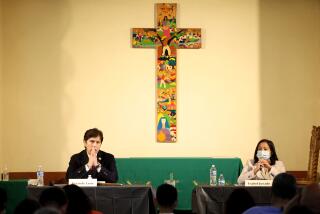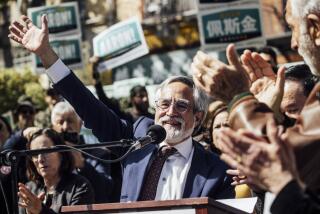The Los Angeles Brand of Biracial Coalition Politics
Los Angeles voters last Tuesday wrote a surprising new chapter in the remarkable story of the city’s biracial coalition--which rather narrowly came together once again to reelect Mayor Tom Bradley to a fifth term.
The way Bradley’s coalition was created and maintained tells us something about what is possible in the city’s future. We might also be able to avoid the fate of cities like New York and Chicago, where the failure to build progressive coalitions led to electoral defeats.
Los Angeles politics is, by necessity, coalition politics. No single group has the numbers to win power by itself. Blacks constitute less than 17% of the city’s population. While Latinos have increased, their low voter registration has made it hard to translate numbers into power. Jews, the most liberal white group in the city, do not exceed 7% of the population. There are even fewer Asian-Americans.
The Bradley coalition grew out of two enduring Los Angeles realities. First, the black community is the most unified and consistently liberal in the city. Second, the white community is severely split along ideological lines.
The two poles of Los Angeles politics have been the black community on the left and the conservative white community on the right. The fundamental differences between these two worlds constitute the roots of major city conflict.
In each city election between 1965 and 1985, black districts and conservative San Fernando Valley districts have been on opposite sides. In Bradley’s mayoral campaigns, and in his two races for governor, he attained his highest vote in the black community and his lowest in the northwest and central valley.
The 5th Council District, now represented by Zev Yaroslavsky and about one-third Jewish, has been the home of white liberalism. It differs profoundly from conservative Valley districts in political choices. On the average, Yaroslavsky’s district and the valley regions have been 20-30 percentage points apart on city, state and national elections; these differences have marked Bradley’s mayoral and gubernatorial races.
The key to the Bradley coalition has been the linkage between two liberalisms, black and white. The coalition that eventually took city hall away from Sam Yorty in 1973 had its roots in the 1963 campaign to elect Bradley as 10th District councilman. In that multiracial district with large black and Jewish communities, black activists joined forces with Jewish liberal reformers. Bradley’s biracial organization, led by black and Jewish activists, provided the model and key personnel for the government to come. Ten years later, blacks and white liberals, long shut out of citywide power, gained control of city hall.
What held this part of the coalition together? We have heard much about Bradley’s personality and symbolic appeals. Both are important, but it should also be understood that Bradley and his black and liberal allies have used specific coalition techniques. Black activists led by Bradley openly rejected anti-Semitism, and white liberal activists paid respect to the independent political role of the black community. When conflicts arose between blacks and Jews, Bradley associates often called closed-door meetings to air differences and forge unity. It was no accident at all, but rather the careful application of such coalition techniques, that allowed Los Angeles to avoid the interracial tensions devastating to coalitions in New York City.
Beyond this biracial base, the coalition expanded to incorporate downtown business and the Latino community. Latinos joined late, having backed Yorty in 1969. But in successive elections, their support for the liberal regime increased steadily. Bradley’s downtown redevelopment programs brought him unswerving business support and established a key role for business in the regime. Thus a black-Jewish alliance expanded into a minority- liberal-business coalition.
This center-left coalition has pursued policies of moderate liberalism, including affirmative action in city hiring, greater civilian control over the police, extensive federal aid (before the onset of the Reagan presidency) and downtown redevelopment.
In 1977, 1981 and 1985 liberal politicians calculated the odds of facing Bradley and decided not to run. So did the strongest conservatives. Bradley then faced and outgunned weaker conservative opponents and won easily. But the same script did not play all the way out this year. For the first time since Jesse Unruh ran in the 1973 mayoral primary, Bradley faced direct competition for his liberal base. He lost votes not just on the right, which was normal, but in the liberal Westside and in the Central City, while being hurt by the apathy of his own supporters.
City Councilman Nate Holden and former Los Angeles County Supervisor Baxter Ward together exceeded Bradley’s vote in the conservative white Valley districts. Bradley’s base was the same as usual: minority districts added to the white liberal 5th District. The 5th was the only white majority district where Bradley exceeded 50%. Fortunately for the mayor, a contested council race in the 5th brought a comparatively massive turnout. But, like Unruh in 1973, Holden cut into Bradley’s support in each of these areas. Bradley’s normal 85%-90% range in the three main black districts fell toward 70%; his usual 65%-70% in the 5th dropped to 51.4%.
Clearly all is not well in the dominant coalition. Bradley’s 52% showing certainly was a major shock. But in terms of coalition evolution, the shifting pattern is not unexpected. A majority coalition of the center and the left is likely to be highly popular with the majority of voters, but over time will have growing problems with the activists who provide the energy and sharp edge to politics. When a coalition becomes too big and cautious, it becomes an inviting target for dissension from within.
The problem for progressives in Los Angeles today is quite different from that facing Bradley and his allies in 1973. Liberalism was newly emergent then and had just barely won over a long-dominant conservatism. Now, liberalism is a stable regime, whose power is taken for granted. But the examples of Chicago and New York City tell us that liberal power can collapse, and when it does, it will happen from within. If a center-left coalition divides down the middle, the winner will be a resurgent conservatism.
The air is filled with new ideas, and we see new activists everywhere. Many groups now seek a greater role in the city’s progressive politics: blacks, Westside liberals, Latinos, Asians and women. Seeking to establish new city policies, they may be less interested in building coalitions. On the other hand, those who seek to maintain existing coalitions may have difficulty creating new policies. The future of progressive politics in Los Angeles can only be assured if one of two things happens: new activists learn to build coalitions, or existing leaders develop new policies.
It is not necessary to agree with all of Bradley’s policies in order to see the necessity of learning from the model of coalition politics his experience offers. It is only necessary to be concerned about the future of progressive politics in the city. While new sorts of policies may be desirable, it will be impossible to implement any of them without a successful strategy for winning and holding power.
Once lost, power is hard to recover. Coalitions succeed when leaders hold the loyalty of their own group while reaching out to others. The reward is electoral victory, and the opportunity to bring about social change.
More to Read
Sign up for Essential California
The most important California stories and recommendations in your inbox every morning.
You may occasionally receive promotional content from the Los Angeles Times.









